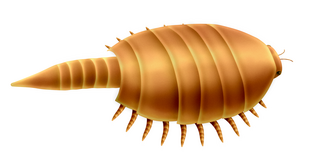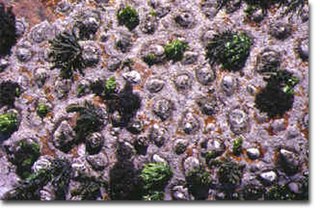
Nektaspida is an extinct order of non-mineralised artiopodan arthropods. They are known from the mid-Cambrian to the upper Silurian. Originally classified as trilobites, which they superficially resemble, they are now placed as close relatives as members of the Trilobitomorpha within Artiopoda. The order is divided into three major families; Emucarididae, Liwiidae, and Naraoiidae.

Coralline algae are red algae in the order Corallinales. They are characterized by a thallus that is hard because of calcareous deposits contained within the cell walls. The colors of these algae are most typically pink, or some other shade of red, but some species can be purple, yellow, blue, white, or gray-green. Coralline algae play an important role in the ecology of coral reefs. Sea urchins, parrot fish, and limpets and chitons feed on coralline algae. In the temperate Mediterranean Sea, coralline algae are the main builders of a typical algal reef, the Coralligène ("coralligenous"). Many are typically encrusting and rock-like, found in marine waters all over the world. Only one species lives in freshwater. Unattached specimens may form relatively smooth compact balls to warty or fruticose thalli.

Isotelus is a genus of asaphid trilobites from the middle and upper Ordovician period, fairly common in the Northeastern United States, northwest Manitoba, southwestern Quebec and southeastern Ontario. One species, Isotelus rex, is currently the world's largest trilobite ever found as a complete fossil, and was probably exceeded in size only by Hungioides bohemicus, in which the specimens probably exceeding Isotelus rex in size are only known from partial remains.
Leiosphaeridia is a form-genus of acritarchs proposed by Eisenack in 1958. The grouping was refined to represent a more natural group by Jankauskas.
Chaetocladus is an extinct non-calcifying genus of unicellular green algae known from the Upper Silurian.

Euthycarcinoidea are an enigmatic group of extinct possibly amphibious arthropods that ranged from Cambrian to Triassic times. Fossils are known from Europe, North America, Argentina, Australia and Antarctica.
In algal anatomy, a pit connection is a hole in the septum between two algal cells, and is found only in the red algae − specifically, all orders except the Porphyridiales and haploid Bangiales. They are often stoppered with proteinaceous "pit plugs". By contrast, many fungi contain septal pores − an unrelated phenomenon.
Phymatolithon is a genus of non geniculate coralline red algae, known from the UK, and Australia. It is encrusting, flat, and unbranched; it has tetrasporangia and bisporangia borne in multiporate conceptacles. Some of its cells bear small holes in the middle; this distinctive thallus texture is termed a "Leptophytum-type" thallus surface, and has been posited as a taxonomically informative character. It periodically sloughs off its epithallus, reducing its overgrowth by algae by as much as 50% compared to bare rock.
Graticula, formerly incorrectly named Craticula, is a genus of Palaeozoic coralline alga. They form the framework of reef rocks in the Silurian of Gotland, from the Högklint, Slite and Halla groups.
Robustum nodum is the one species of a problematic genus of Ordovician hemithecellid mollusc proposed by Stinchcomb and Darrough in 1995. Its similarities to Matthevia were outlined by Vendrasco & Runnegar.

The extinct Solenoporaceae have traditionally been interpreted as a group of red algae ancestral to the Corallinales.
Archaeolithophyllum is a genus of conceptacle-bearing red alga that falls in the coralline stem group. It somewhat resembles Lithophyllum.
Arenigiphyllum is a genus of alga from the Ordovician that falls in the coralline stem group. Only its vegetative anatomy is known.
Petrophyton is a genus of alga that falls in the coralline stem group.
The Archaeolithophyllaceae are a family of algae that are thought to represent the stem lineage of the corallinaceae.
The epithallium or epithallus is the outer layer of a crustose coralline alga, which in some species is periodically shed to prevent organisms from attaching to and overgrowing the alga.
Palaeoaplysina is a genus of tabular, calcified fossils that are a component of many Late Palaeozoic reefs. The fossil acted as a baffle to trap sediment. Historically interpreted as a sponge or hydrozoan, recent studies are converging to its classification in the coralline stem group, placing it among the red algae.

Paleontology in Oklahoma refers to paleontological research occurring within or conducted by people from the U.S. state of Oklahoma. Oklahoma has a rich fossil record spanning all three eras of the Phanerozoic Eon. Oklahoma is the best source of Pennsylvanian fossils in the United States due to having an exceptionally complete geologic record of the epoch. From the Cambrian to the Devonian, all of Oklahoma was covered by a sea that would come to be home to creatures like brachiopods, bryozoans, graptolites and trilobites. During the Carboniferous, an expanse of coastal deltaic swamps formed in areas of the state where early tetrapods would leave behind footprints that would later fossilize. The sea withdrew altogether during the Permian period. Oklahoma was home a variety of insects as well as early amphibians and reptiles. Oklahoma stayed dry for most of the Mesozoic. During the Late Triassic, carnivorous dinosaurs left behind footprints that would later fossilize. During the Cretaceous, however, the state was mostly covered by the Western Interior Seaway, which was home to huge ammonites and other marine invertebrates. During the Cenozoic, Oklahoma became home to creatures like bison, camels, creodonts, and horses. During the Ice Age, the state was home to mammoths and mastodons. Local Native Americans are known to have used fossils for medicinal purposes. The Jurassic dinosaur Saurophaganax maximus is the Oklahoma state fossil.

Spongites yendoi is a species of crustose red seaweed with a hard, calcareous skeleton in the family Corallinaceae. It is found on the lower shore as part of a diverse community in the southeastern Atlantic Ocean and the Indo-Pacific Ocean.

Villebrunaster is an extinct genus of starfish-like animal belonging to Asterozoa that lived around 480 million years ago during Early Ordovician Period in modern-day southern France and Morocco. As of 2022, it contains two species, namely V. thorali and V. fezouataensis. V. thorali was described in 1951 and V. fezouataensis was described in 2021. Villebrunaster represents one of the oldest members of asterozoans, and perhaps, according to a description in 2021, the earliest divergent stem-group of Asterozoa.







